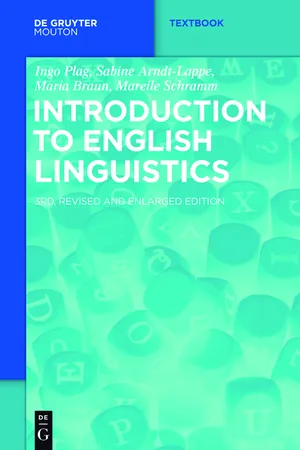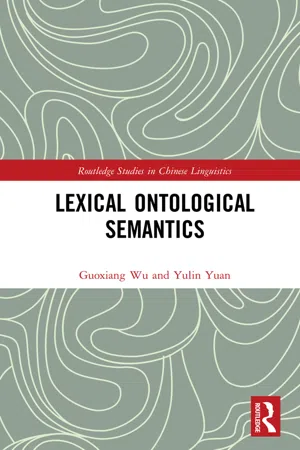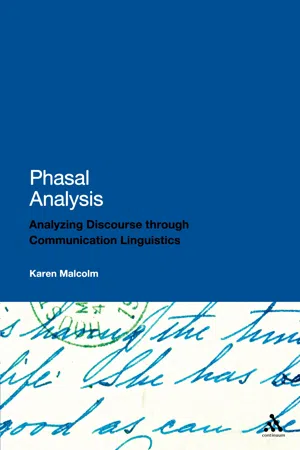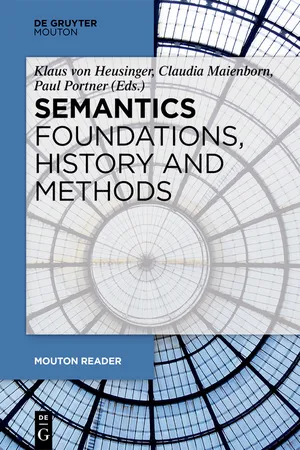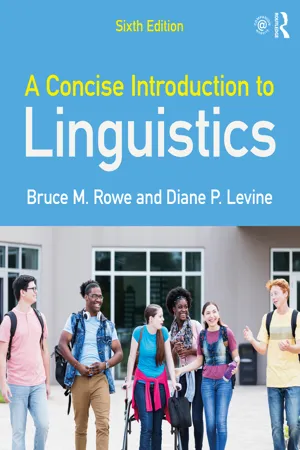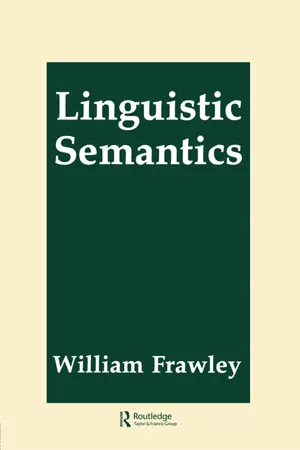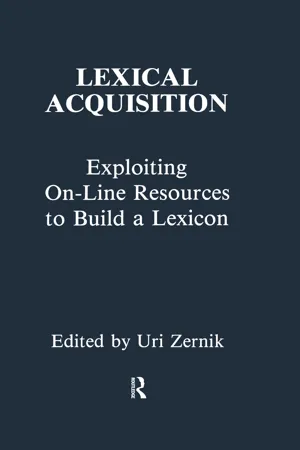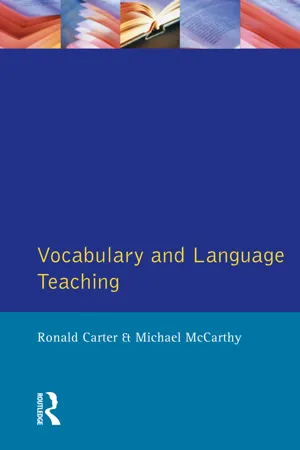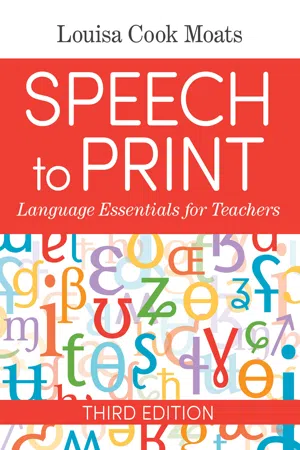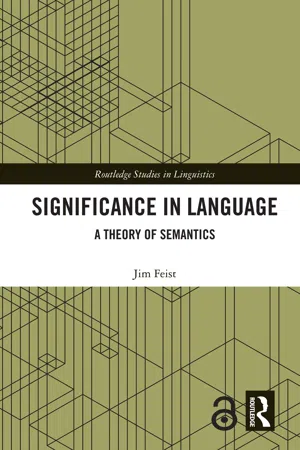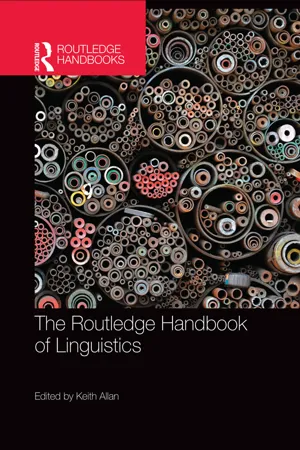Languages & Linguistics
Lexis and Semantics
Lexis refers to the vocabulary or words used in a language, while semantics deals with the meaning of those words and how they are used to convey meaning. Lexis and semantics are essential components of language, as they help to shape and convey the intended message in communication. Understanding the relationship between lexis and semantics is crucial for effective language use and comprehension.
Written by Perlego with AI-assistance
Related key terms
11 Key excerpts on "Lexis and Semantics"
- eBook - ePub
- Ingo Plag, Sabine Arndt-Lappe, Maria Braun, Mareile Schramm(Authors)
- 2015(Publication Date)
- De Gruyter Mouton(Publisher)
5 The meaning of words and sentences: semantics
5.1Introduction
Semantics is the study of the structure of meaning. To us as speakers of a language, the idea that language is used to communicate meaning seems intuitively quite straightforward. However, we will see in this chapter that, if we look at how meaning is actually encoded in language, things are much more complex than they seem. First of all we may wonder what meaning is in the first place. This question will be discussed in section 5.2 . Secondly, we may wonder which linguistic units are relevant for meaning, and we will look at this question in section 5.3 . Section 5.4 . will then be concerned in more detail with the ways in which meaning is organised in language. As an example, we will deal with the organisation of word meaning in the speaker’s mind.5.2What does ‘meaning’ mean? Words, concepts and referents
In contrast to maybe other linguistic structures, we are quite used to consciously dealing with semantic issues in everyday life. The linguistic unit with which we tend to associate meaning is the word. When we meet a word in a language that is unknown to us, we may consult a dictionary in order to find out about its meaning. Imagine, for example, you came across the word box , and you did not know what it meant. In (1) you find an extract from what the Longman Dictionary of Contemporary English will tell you about the meaning of box .(1) Longman Dictionary of Contemporary English, s.v. boxa. A definition in English:‘a container for putting things in, especially one with four stiff straight sides’ b. Six pictures:(Longman Dictionary of Contemporary English (2003), printed with permission)In how far can this definition and these pictures tell us something about what meaning is to speakers of a language? We can draw an analogy between the dictionary entry and the way in which language organises meaning.The word box itself is a combination of four sounds: [b], [ ], [k] and [s]. This combination is arbitrary in the sense that there is nothing special about this sequence of sounds that would make them particularly suitable to be used to refer to box-like objects. For example, we may take three of those sounds, put them in a different order, and arrive at a completely different word that has absolutely nothing to do with boxes: sock ([s] + [ - eBook - ePub
- Guoxiang Wu, Yulin Yuan(Authors)
- 2019(Publication Date)
- Routledge(Publisher)
Introduction From lexis to lexical ontological semanticsKnowledge that mediates between Lexis and Semantics has been structured into what is referred to as linguistic ontologies. Among them, grammars are important forms. A grammar usually organises words into noun, verb, adjective, and other parts of speech according to what they mean and how they function. Because lexical items denote objects, events, states or attributes in the physical or mental world, a linguistic ontology serves not only as a bridge between Lexis and Semantics but also as an interface between linguistic knowledge and world knowledge.Lexis and grammarThe belief that the ever-evolving feature shared by human languages should be manifested in linguistic studies is deeply rooted in both Indo-European and Sino-Tibetan traditions. In the beginning chapter of On Interpretation, Aristotle summarises the one-sided relation between words and meanings as ‘spoken words represent mental experience and written words represent spoken words’ (Ἔστι μὲν οὖυ τὰἐν τῇ φωνῇ τῶν ἐν τῇ ψυχῇ παθηάμτων σύμβολα, καὶ τὰ γραφόμενα τῶν ἐν τῇ φωνῇ ). This statement clearly shows that written language corresponds to spoken language and spoken language does to mental experience. As Confucius puts it with regard to the same relation in the 12th chapter of The Great Appendix, however, ‘written language does no traverse spoken language and spoken language does no traverse all ideas’ (书不尽言 ,言不尽意 shū bù jìn yán, yán bù jìn yì). That is to say, written language fails to retrieve all spoken facts; neither does spoken language capture all mental experiences. To exhaust all potential meanings and fully set forth ideas, abstract symbols are accordingly created (立象以尽意 lì xiàng yǐ jìn yì).It remains an important task in modern linguistics to fill the gap between mental experiences (knowledge) and linguistic symbols (representation). One way to approach this task is to go through grammar. In its classical sense, ‘the art of grammar’ (téchnē grammatikḗ [τέχνηγ ραμματική - eBook - ePub
Phasal Analysis
Analysing Discourse through Communication Linguistics
- Karen Malcolm(Author)
- 2010(Publication Date)
- Continuum(Publisher)
Lexis 4 Lexis is the study of the organization of the meanings of words. Communication works because people share meanings. Meanings are organized into taxonomies / groups of relatedness. If someone says the word cat, not only do numerous attributes of cats come to mind like animal, tail, paw, whiskers, fur, meow, but so do several related words such as gray, white, stray, tabby, scratch, purr, pet. The former denotative meanings of a word like cat include the attributes of cats that are held more or less universally. These meanings are the ones used in dictionary definitions like ‘ a small furry domesticated animal often kept as a pet ’ (Oxford English Dictionary). The latter connotative meanings are more general, associated with cat more by proximity than exclusivity. Connotations are more likely to be situationally and culturally specific. When children talk to friends about their pet cat they use words like Mukti (name), cuddly, purr, gray, Persian. Professional cat breeders, however, use a very different group of words to discuss cats at cat shows: Koret, registered (not purebred), lilac point, locket, bracelet, ticking, dam, sire, altered, spay. Such specialized, technical words are called field-restricted words or jargon. Language users understand the meanings of words in terms of the beliefs, values, expectations and stereotypes associated with their culture. Despite the common referent (thing in the world), each language has its own referring expression : in English, cat ; in French, chat. Communicators also understand the meaning of the present instantial discourse by comparing it to their non-instantial memories of past linguistic experiences of such meanings. Although individuals can easily misinterpret the meaning of a word that is emotionally charged for them, it seems that people share enough meaning to understand one another more or less - eBook - ePub
- Klaus Heusinger, Claudia Maienborn, Paul Portner(Authors)
- 2019(Publication Date)
- De Gruyter Mouton(Publisher)
Formenlehre ). Reisig claims that the word should not only be studied with regard to its form (etymology) and in its relation to other words (syntax), but as having a certain meaning. He points out that there are words whose meaning is neither determined by their form alone nor by their place in the sentence, and that the meaning of these words has to be studied by semasiology. More specifically semasiology is the study of the development of the meaning of certain words, as well as the study of their use, both phenomena that were covered by neither etymology nor syntax.Reisig puts forward thirteen principles of semantics, according to which language precedes grammar, languages are the products of nations, not of single human beings, language comes into being through imagination and enthusiasm in the social interaction of people. We shall see that this dynamic view of language and semantic change became central to historical semantics at the end of the 19th century when it was also linked to a more contextual approach. According to Reisig the evolution of a particular language is determined by free language-use within the limits set by the general laws of language. These general laws of language are Kant’s laws of pure intuition (space and time), and his categories. This means that language and language change are brought about by a dynamic interplay of several forces which Reisig derived from his knowledge of German idealism on the one side and the romantic movement on the other. In line with German idealistic philosophy, he wanted to find the general principles of semantic change, assumed to be based on general laws of the human mind. In tune with the romantic movement, he saw that every language has, however, its individuality, based on the history of the nation and he recognized that speakers too have certain degrees of freedom in their creative use of language. This freedom is however constrained by certain habitual associations between ideas which had already been discussed in rhetoric, but which semasiology should, he claims, take account of, namely synecdoche, metonymy and metaphor. Whereas rhetoric focuses on their aesthetic function, semasiology focuses on the way these figures have come to structure language use in a particular language. - eBook - ePub
- Bruce M. Rowe, Diane P. Levine(Authors)
- 2022(Publication Date)
- Routledge(Publisher)
www.ling.uni-potsdam.de/~koller/papers/sem-handbook.pdf .- Kövecses, Zoltan, Metaphor: A Practical Introduction , 2nd ed., New York: Oxford University Press, 2010.
- Saeed, John I., Semantics , 5th ed., Oxford: Wiley-Blackwell, 2022.
- Schubert, Lenhart, “Computational Linguistics,” in The Stanford Encyclopedia of Philosophy , ed. Edward N. Zalta, Spring, 2015. Available at https://plato.stanford.edu/archives/spr2015/entries/computational-linguistics .
Websites
- Korzybski’s General Semantics: Applying Science-Mathematical Methods and Discoveries to Daily Living: www.stevenlewis.info/gs . An interesting, eclectic collection of essays and articles on a site developed by Steven Lewis .
- Semiotics for Beginners : http://visual-memory.co.uk/daniel/Documents/S4B/
- TeachIt: www.teachit.co.uk/armoore/lang/semantics.htm . Free resources from an English teaching website for semantics, etymology, and the lexicon, with links to much more .
Review of terms and concepts: semantics
- Semantics is the study of _____________________________________________________________________________.
- A ________ is something, a word, a gesture, a sign, or other representation that signifies or represents something else that is not intrinsically (causally) related to it.
- The meaning of the symbol and what it signifies must be ___________.
- Unlike a symbol, an __________________ has a causal relationship to what it indicates.
- Lexical semantics is the study of ______________.
- In the brain is a ______________ containing the definitions of all the words that a person knows.
- Some words have an actual concrete item or concept that the word refers to. That item is its ______________.
- eBook - ePub
- William Frawley(Author)
- 2013(Publication Date)
- Routledge(Publisher)
11.1. INTRODUCTIONSemantics and Linguistic Semantics: Toward Grammatical Meaning
In this chapter we define linguistic semantics as the study of literal, decontextualized, grammatical meaning. We begin with the difference between literal and implicational meaning and then illustrate meaning that has grammatical relevance. We contrast this view of meaning with that given by philosophical semantics, focusing on two basic questions: Is meaning possible? What kinds of meanings are possible? We show how linguistic semantics positions itself differently from philosophical semantics on such issues as the kinds of meaning that languages grammaticalize and the structural and empirical methods of semantic analysis. We close with a consideration of grammatical conditions on meaning and the relation of semantics to morphology.1.2. GRAMMATICAL MEANING: AN INTRODUCTION AND ILLUSTRATIONLinguistic semantics is the study of literal meanings that are grammaticalized or encoded (i.e., reflected in how the grammar of a language structures its sentences). Defined as such, linguistic semantics is a branch of both semiotics, the study of meaning in general, and semantics, the study of linguistic meaning in particular. But linguistic semantics is narrower than either semiotics or semantics, focusing as it does on meanings that are actually reflected in overt form differences.To see exactly what linguistic semantics admits and excludes, we begin with an example that illustrates grammatical meaning in contrast to other kinds of meaning. Thereafter, we examine the position of linguistic semantics in relation to semantics in general so that we can delimit more precisely the domain of linguistic semantics.1.21. Literal and Implicational Meaning What does (1) mean? 1. Tom bought some rice.We want to know what state of affairs or situation in the world the expression represents. This is its literal or representational meaning. The literal meaning of a linguistic form contrasts with its implicational meaning, - eBook - ePub
Lexical Acquisition
Exploiting On-line Resources To Build A Lexicon
- Uri Zernik(Author)
- 2021(Publication Date)
- Psychology Press(Publisher)
• Conceptual semantics is in the linguist’s and philosopher’s mind. The lexicographer’s viewpoint on conceptual categories is reflected in dictionaries. • Naive semantics is in people’s mind. It is best acquired from psycholinguistic experiments. • Technical semantics is human expert’s knowledge. It can be acquired by a full parsing of technical documents, or by interviewing expert. • Surface semantics is in everyday language. It can be induced from word cooccurrences in texts.Our thesis is that surface semantics is more adequate for the purpose of an extensive codification. But the very problem is: How useful is it for a robust natural language processing? This issue alone could be the topic of a full paper. Let me skip on this. In the literature it is shown that surface semantics is useful at disambiguating word senses and at detecting meaning relations among words in a sentence. The definitions (2), (3), and (4) are actual lexical entries of some implemented NLP system, whose usefulness is, if not strictly demonstrated, at least claimed in the referenced works.There is no doubt, however, that many reasoning mechanisms are not enabled by surface semantics. For example, taxonomic knowledge is the basis of language processing and must be encoded, despite the many difficulties of this task. My point here is not to neglect important aspects of meaning. Rather, I would like to examine the problem of meaning representation under the practical perspective of achieving semantic coverage, as this will ultimately determine how widespread NLP systems will be in the near future.Let me draw some conclusion out of the previous two sections:13.1.3 Summary Guidelines for Meaning Representation in Lexica
• Understanding the nature of human communication is not - eBook - ePub
- Ronald Carter, Michael Mccarthy(Authors)
- 2014(Publication Date)
- Routledge(Publisher)
1986a ) is a recent, significant example.3 But what about the other 400,000 words?
At this point in our discussion this is a fair question. Even if features such as logical text connexion, information weighting and discourse marking are to be reassessed as within the lexicon, this would still surely account for at most only a handful of vocabulary items, however central to the way we structure our language these items are considered to be. So what can text/discourse studies tell us about the nature, organization and use of all of those thousands of items crammed into even the smallest of dictionaries?In general, lexis in applied linguistics has been conditioned by two parallel views, the semantic and the ‘lexical’ (see Chapter 2 ). Both views converge in seeing lexical items as contracting relationships on the ‘horizontal’ or syntagmatic (left-to-right) axis (collocation) and relationships on the ‘vertical’ or paradigmatic axis (lexical sets). Lexis can be compared with grammar in the following way:syntagmatic paradigmatic grammar structure system lexis collocation set Examples of systems in grammar would be the closed set of choices between this/that/these/those, or the system of pronouns. Something similar is held to obtain in ‘open’ lexical sets, where words can be grouped together as realizations of meaning systems or ‘fields’. In the cooking terms which Lehrer (1974 ) was interested in, sets can be found the members of which can be identified by their distribution and mutual exclusiveness (see Chapter 2 ). For example, food may be grated, sliced, crushed, chopped, diced, minced, milled, etc. in order to reduce it into smaller pieces. While the exact membership of the set may have somewhat fuzzy edges, most informants will agree on its central members. These items are in paradigmatic opposition to one another as this is to that. Items within sets will be seen to be in relation to one another either as co-hyponyms (as the cooking terms above are), synonyms or antonyms, and so on. Sets are powerful organizing principles, and have a strong psychological reality for language users and learners, as Channell’s paper in Chapter 4 suggests. They are held to be effective teaching devices for vocabulary (vide Rudzka et al. 1981 and 1985 ) and lie behind part of our ability to recognize cohesive ties in text. Thoeretically at least, it should be possible to organize the entire lexicon of English along these lines, and Roget’s Thesaurus - eBook - ePub
Speech to Print
Language Essentials for Teachers
- Louisa Cook Moats(Author)
- 2020(Publication Date)
- Brookes Publishing(Publisher)
One, the focus of lexical semantics, is that verbal knowledge comprises networks of semantic associations that are built up over time. Words and concepts are known in relation to one another, not as isolated units; strengthening networks of meaning should be an instructional goal. That is, depth of word knowledge matters. A second important idea is that new verbal information is learned in accordance with prior knowledge and that what we understand is both filtered through old knowledge and continually shaped with new experience. Students with weaker prior knowledge are at a disadvantage, with serious implications for vocabulary development and comprehension. A third big idea, the focus of sentential semantics, is that phrase and sentence meanings cohere (are held together) because of several kinds of referential devices that bind the words together. Instruction that honors these ideas and that deliberately links all modes of oral and written language use—listening, speaking, reading, and writing—will be most likely to enhance student comprehension. In this chapter we break the broad field of semantics into the subtopics of lexical semantics, sentential semantics, and pragmatics, considering what is most relevant to informed reading and language instruction in classroom and clinic. Of necessity, we must limit our discussion to factors affecting local-level comprehension (of words, phrases, and meaningful connections within and between sentences), and will leave the topic of “macro” comprehension processes for other sources. WORD KNOWLEDGE AND READING Reading comprehension depends on vocabulary and language proficiencies that develop from infancy - eBook - ePub
Significance in Language
A Theory of Semantics
- Jim Feist(Author)
- 2022(Publication Date)
- Routledge(Publisher)
As to what being “semantic” should be taken to mean, I suggest that there is no fully satisfactory resolution of that problem, either, for two reasons. First, since there is no agreed satisfactory understanding of what I have discussed as “linguistic”, “cognitive”, and “grammatical” meaning, and so on. Second, “meaning” and “semantic” each have several well-established uses (some of them dependent on a specific approach), which will certainly continue. The best we can do, I believe, is to base our terms on the semiotic approach. That approach, treating language as a system of spoken and written signs, provides “language” with a satisfactory definition, and provides a sound basis for analysing it (as phonological, syntactic, morphological, and lexical signs of various types and in various structures).Following the semiotic approach, then, we begin from signs, and the fact that signs have significance. “Significance”, then, makes a reasonable term to cover both what has been thought of as “meaning” or “semantics”, and the range of functions that language has evolved to serve. The significance of an utterance may be the message it was intended to convey, the action it was intended to bring about, the response it was intended to stimulate, the maintenance of social relations it was intended to ensure, and so on. “Significance” also naturally includes intention, which has often been implicit in “meaning”, and which is a characteristic of linguistic functions (even if not always fully conscious); and it can naturally include also the Expressive function, which is often not conscious or deliberate.“Semantic” can then mean “to do with significance in language”. Significance in language is whatever its signs evoke in hearers and readers in accordance with the language’s grammatical system; that excludes idiosyncratic hearer interpretations, and (of course) any “meaning” the speaker intends but does not realise in signs. As to “meaning”, it seems better to extend its meaning to that of significance - eBook - ePub
- Keith Allan(Author)
- 2015(Publication Date)
- Routledge(Publisher)
12 Lexicography The construction of dictionaries and thesauruses Pam Peters 12.1 Introduction Ferdinand de Saussure’s (1916) model for the words of a lexicon – consisting of the signifier (word form) and the signified (word meaning) – set the foundations of modern linguistics. These complementary perspectives also correspond with the two conventional formats for representing a lexicon: the dictionary and the thesaurus. The dictionary is an inventory of the word forms of a language, the thesaurus a complex semantic structure designed to account for all the meanings embedded in the lexicon. In lexicographic terms, the dictionary format is semasiological, and that of the thesaurus onomasiological. Those not entirely transparent words may be explained by the Greek roots they embody: the term semasiological is derived from sema the word for ‘sign’, since dictionaries are constructed out of the regular signifiers of the language; while onomasiological is derived from onoma ‘name’, since thesauruses 1 provide labels for the concepts and meanings (the signifieds) of the lexicon within a multilayered semantic structure. Elementary dictionaries and pioneering thesauruses were published well before de Saussure, the earliest English examples both dating from the seventeenth century. The first small monolingual English dictionary was Robert Cawdrey’s (1604) Table Alphabeticall … of Hard Usuall English Words ; 2 while the English thesaurus was pioneered by John Wilkins (1668) in his bulky Essay Towards a Real Character and a Philosophical Language, 3 using special symbols to designate words and their meanings within a large conceptual hierarchy. These early models were enlarged in the print medium in the centuries following, in response to socio-cultural needs. Each innovation prompted changes in the construction of lexical information within the two types of language reference, as discussed in §§12.2 and 12.3
Index pages curate the most relevant extracts from our library of academic textbooks. They’ve been created using an in-house natural language model (NLM), each adding context and meaning to key research topics.
